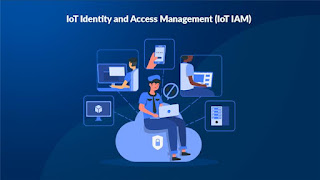IoT Identity and Access Management: Enhancing Security Through Innovation and Interoperability
The global IoT
Identity and Access Management (IAM) market is undergoing rapid evolution,
fueled by innovation and collaboration to meet the rising security demands of
IoT ecosystems. Organizations are significantly investing in research and
development to craft advanced IAM solutions capable of addressing the
complexities of IoT environments.
The integration of artificial intelligence (AI) and machine
learning (ML) technologies has become a cornerstone of this progress, enabling
real-time threat detection and adaptive responses. These technologies enhance
security by analyzing behavioral patterns, identifying anomalies, and
implementing proactive measures to mitigate risks before they escalate. This
shift from reactive to predictive security is pivotal for safeguarding the
expanding IoT landscape.
As the market grows, interoperability and scalability are
becoming critical factors. The diversity of IoT devices necessitates IAM
solutions that can seamlessly integrate across platforms and accommodate
large-scale deployments. Additionally, with increasing regulatory demands,
modern IAM systems are evolving to include robust compliance management
features, ensuring transparency and adherence to global data protection
standards.
By prioritizing innovation, fostering vendor collaboration,
and addressing interoperability and compliance, the IoT IAM market is
positioned to enable secure, scalable, and sustainable connected ecosystems,
driving trust and growth in the digital era.
The Internet of Things (IoT) has transformed the way we live
and work, connecting billions of devices worldwide. However, this rapid
proliferation of IoT devices brings a heightened need for robust Identity and
Access Management (IAM) solutions. These solutions are becoming critical in
addressing security challenges, ensuring compliance, and delivering seamless
user experiences in an interconnected world.
The Growing Complexity of IoT Security
With the increasing number of connected devices, IoT
ecosystems are becoming more complex and vulnerable to cyber threats.
Traditional IAM systems often fall short in addressing the unique challenges
posed by IoT, such as managing diverse device types, securing
machine-to-machine communication, and ensuring scalability for large
deployments. To overcome these limitations, IoT
Identity and Access Management is shifting towards more innovative
approaches that prioritize scalability, interoperability, and automation.
Leveraging AI and ML for Adaptive Security
Artificial intelligence (AI) and machine learning (ML) are
at the forefront of this transformation, enabling IoT Identity and Access
Management solutions to evolve beyond static security measures. AI and ML
technologies provide adaptive security mechanisms capable of monitoring
behavioral patterns, detecting anomalies, and predicting potential threats.
This proactive approach allows organizations to respond to vulnerabilities
before they can be exploited, significantly reducing the risk of data breaches
or operational disruptions.
Predictive analytics, powered by AI and ML, further enhances
security by offering real-time insights into device behavior and access
patterns. These capabilities enable IoT IAM solutions to dynamically adjust
access controls based on contextual factors, such as device location or user
behavior, ensuring both security and user convenience.
Compliance Management in an Evolving Regulatory Landscape
As IoT adoption grows, so does the need for compliance with
data protection regulations such as GDPR, CCPA, and industry-specific
standards. Modern IoT IAM solutions are increasingly incorporating compliance
management features, allowing organizations to maintain transparency and
accountability in their data practices. These features include audit trails,
automated reporting, and granular access controls, which streamline regulatory
adherence and mitigate legal risks.
Promoting Interoperability and Ecosystem Collaboration
One of the key trends shaping the future of IoT IAM is the
push towards interoperability. IoT environments often consist of devices from
multiple vendors, making it crucial to establish a unified security framework.
Vendors are increasingly collaborating to create open standards and integrated
security ecosystems that ensure seamless interoperability across devices and
platforms. This collaborative approach simplifies the management of IoT
security, reduces fragmentation, and enhances the overall resilience of IoT
deployments.
The Path Forward
The future of IoT
Identity and Access Management lies in balancing security with scalability
and usability. By leveraging AI-driven innovation, expanding interoperability,
and focusing on compliance, IoT IAM solutions are addressing the multifaceted
challenges of securing connected devices. As organizations continue to adopt
IoT technologies, fostering vendor collaboration and advancing IAM capabilities
will be essential to building secure and sustainable IoT ecosystems.
In an era defined by connectivity, IoT IAM is not just a security necessity—it is a foundation for enabling trust, innovation, and growth in the digital age.
.png)


Comments
Post a Comment